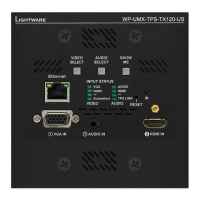UMX-TPS-TX100 series – User's Manual 68
Change the Video Input Priorities
Description: The settings of video input priority can be changed as follows.
Format Example
Command {PRIO_V<out>=<in
1
_prio>;
<in
2
_prio>;…;<in
n
_prio>}
Response (PRIO_V<out>=<in
1
_prio>;
<in
2
_prio>;…;<in
n
_prio>)CrLf
{prio_v1=1;0;2;3;4;5}
(PRIO_V1=1;0;2;3;4;5)
Legend:
<out>: The output port number: V1
<in1_prio>…<inn_prio>: Priority number of the input ports. See more details
about port numbering in the Port Numbering section.
Explanation: Input 2 has the highest priority (0), Input 1 has the second highest (1). Input 6 has the lowest
priority (5).
ATTENTION! Always set all the priority of the ports when changing, otherwise, the change will not be
executed and the response will be the current setting (like querying the priority setting).
INFO: The video priorities can be queried by typing the “prio_v<out>=?” command.
Change Audio Input Priority
Description: The settings of video input priority can be changed as follows.
Format Example
Command {PRIO_A<out>=<in
1
_prio>;
<in
2
_prio>;…;<in
n
_prio>}
Response (PRIO_A<out>=<in
1
_prio>;
<in
2
_prio>;…;<in
n
_prio>)CrLf
{prio_a1=1;0;2;3;4}
(PRIO_A1=1;0;2;3;4)
Legend:
<out>: The output port number: A1
<in1_prio>…<inn_prio>: Priority number of the input ports. See more details
about port numbering in the Port Numbering section.
Explanation: Input 2 has the highest priority (0), Input 1 has the second highest (1). Input 5 has the lowest
priority (4).
ATTENTION! Always set all the priority of the ports when changing, otherwise, the change will not be
executed and the response will be the current setting (like querying the priority setting).
INFO: The audio priorities can be queried by typing the “prio_a<out>=?” command.
Description: IP address settings can be queried as follows.
Format Example
Command {IP_STAT=?}
Response (IP_STAT=<type>;<ip_address>;
<subnet_mask>;<gateway_addr>)CrLf
{ip_stat=?}
(IP_STAT=0;192.168.0.100;255.255.255.0;
192.168.0.1)
Legend:
<type>: 0 = static IP; 1 = DHCP.
<ip_addr>: IP address (four decimal octets separated by dots).
<subnet_mask>: Subnet mask (four decimal octets separated by dots).
<gateway_addr>: Gateway address (four decimal octets separated by dots).
Explanation
gateway address is 192.168.0.1.
Set the IP Address
Description: IP address can be set as follows.
Format Example
Command {IP_ADDRESS=<type>;<ip_address>}
Response (IP_ADDRESS=<type>;<ip_address>)CrLf
{ip_address=0;192.168.0.110}
(IP_ADDRESS=0;192.168.0.110)
Legend: <type>: 0 = static IP; 1 = DHCP
INFO: The IP address can be queried by typing the “ip_address=?” command. The response contains the
Set the Subnet Mask
Description: Subnet mask can be set as follows.
Format Example
Command {IP_NETMASK=<subnet_mask>}
Response (IP_NETMASK=<subnet_mask>)CrLf
{ip_netmask=255.255.255.0}
(IP_NETMASK=255.255.255.0)
Legend: <subnet_mask>: Four decimal octets separated by dots.
INFO: The subnet mask can be queried by typing the “ip_address=?” command. The response contains
mask is not valid.

